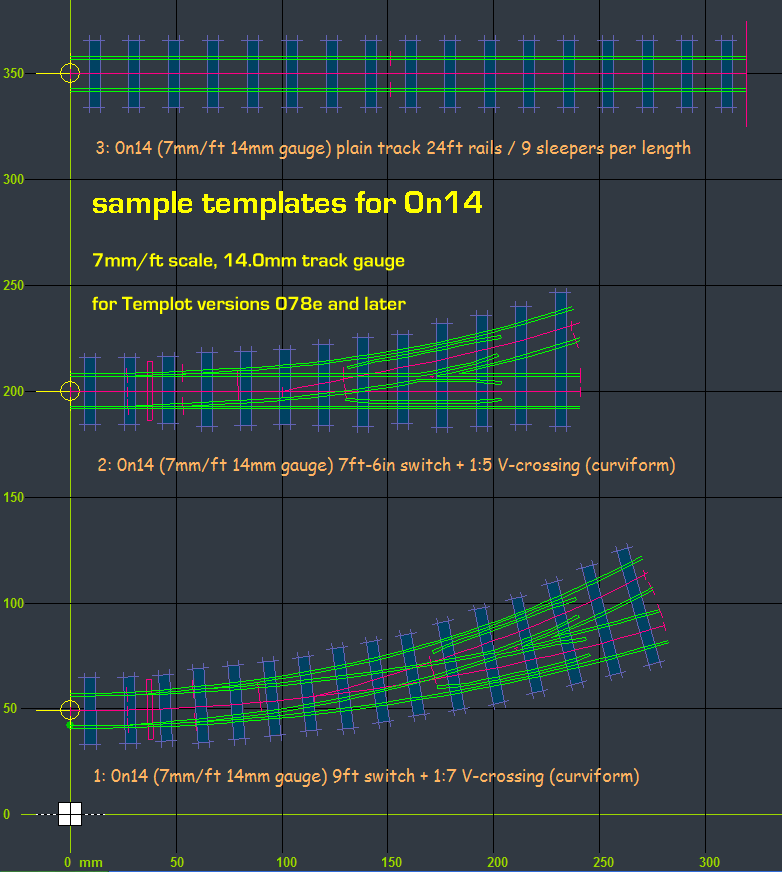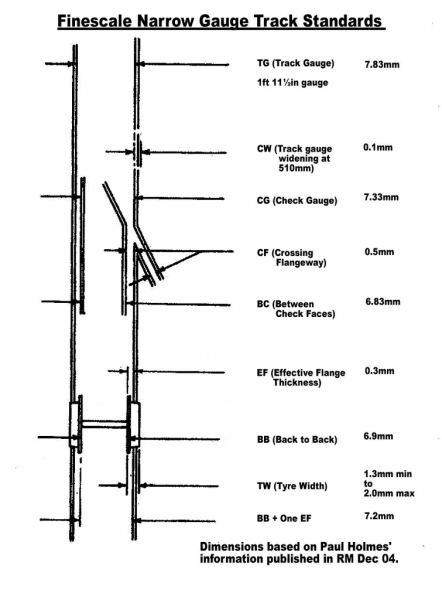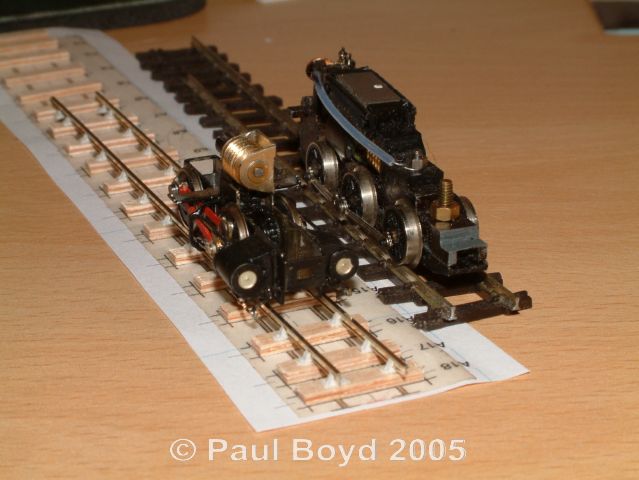Templot Club Archive 2007-2020
|
|||
| author | remove search highlighting | ||
|---|---|---|---|
|
posted: 16 Feb 2012 14:15 from: John Clutterbuck click the date to link to this post click member name to view archived images |
Dear Martin, Please can you add O14 as an official gauge in TDV as it is being increasingly used by several Templot users as evidenced by previous discussions on this group. Based on the published standards (available at O14 Group Standards ) my suggested settings are as follows: 7.00 mm SCALE per ft. ( RATIO 1:43.54 ) 14.00 mm GAUGE between running rails. 1.00 mm flangeway gap. 2.00 mm flangeway end gap (check rail flared ends). 70.00 mm adjacent track centres, turnout side. 70.00 mm adjacent track centres, main side. 600.00 mm minimum radius limit for warnings. Please let me know if you need any further details? Finally please note we agreed in 2008 that the official designation is O14 (i.e. Capital Letter O followed by 14) and not o14 or O-14 as often used. Regards John Clutterbuck (O14 group moderator) |
||
|
posted: 16 Feb 2012 17:15 from: Martin Wynne
click the date to link to this post click member name to view archived images |
John Clutterbuck wrote:Please can you add O14 as an official gauge in TDV as it is being increasingly used by several Templot usersHi John, I made a decision a long time ago not to include any narrow-gauge pre-sets in the gauge list. There are just too many of them. When I tried to include them the list was swamped with them and it was difficult to find the standard-gauge settings among them. All you need to do is post a .box file containing some 0n14 templates with the desired custom settings. Your members can download the file and will then be able to use the 0n14 settings in Templot. In fact there are already some 0n14 sample templates available for download, although I would need to check* the dimension settings which I used -- you could easily modify them if necessary: 0n14_samples.png  Download from: topic 28 Finally please note we agreed in 2008 that the official designation is O14 (i.e. Capital Letter O followed by 14) and not o14 or O-14 as often used.Historically the model railway gauge designations are numeric, so that should be 0n14 not On14. If you use letter O, the next size up would have to be Gauge P instead of Gauge 1. I think it makes sense to include the letter n in narrow-gauge designations to avoid confusion. I'm hoping eventually to have an online library of custom template files. Members have uploaded a great many .box files over the years, but they need updating for later versions and indexing. *edit: flangeway gap: 1.25mm end gap: 2.5mm track centres: 63mm radius warning: 450mm Easily modified to your settings. regards, Martin. |
||
|
posted: 16 Feb 2012 18:19 from: John Clutterbuck click the date to link to this post click member name to view archived images |
Martin Wynne wroteI made a decision a long time ago not to include any narrow-gauge pre-sets in the gauge list. There are just too many of them. When I tried to include them the list was swamped with them and it was difficult to find the standard-gauge settings among them.OK that's a fair point, although have you ever considered a customisable text (INI or XML) file so user's can have there own favourite gauges on tap, rather than a long list 95% of which users never use. Historically the model railway gauge designations are numeric, so that should be 0n14 not On14. If you use letter O, the next size up would have to be Gauge P instead of Gauge 1.I beg to disagree. The "n" notation has commonly become a reference to prototype dimensions (albeit with a perverse mix of feet and inches) in a particular scale such as: Sn3, On2, On30, On3. Thus On14 would mean an O scale model of a 14" gauge railway - just like Gn15 is in 15" in G scale. Most UK narrow gauge modellers now use a prefix and number to signify scale with the gauge in millimetres such as OO9 or O14, O16.5, O21 etc. John |
||
| Last edited on 16 Feb 2012 18:22 by John Clutterbuck |
|||
|
posted: 16 Feb 2012 18:47 from: Martin Wynne
click the date to link to this post click member name to view archived images |
John Clutterbuck wrote:have you ever considered a customisable text (INI or XML) file so user's can have their own favourite gauges on tap, rather than a long list 95% of which users never use.Hi John, Users can easily have their own gauges on tap. Just load or add a .box file containing the relevant library templates, click on the one you want, and copy it to the control. This gives you total design flexibility to create any custom settings, re-use them and share them with other users. The "n" notation has commonly become a reference to prototype dimensions (albeit with a perverse mix of feet and inches) in a particular scale such as: Sn3, On2, On30, On3. Thus On14 would mean an O scale model of a 14" gauge railway - just like Gn15 is in 15" in G scale.Well yes. The gauge designations are an unholy mess and probably always will be. I would regard the n as simply flagging "narrower than standard-gauge", and the numbers could mean almost anything when you add the metric gauges into the mix. regards, Martin. |
||
|
posted: 16 Feb 2012 20:55 from: Paul Boyd
click the date to link to this post click member name to view archived images |
Most UK narrow gauge modellers now use a prefix and number to signify scale with the gauge in millimetres such as OO9 or O14, O16.5, O21 etc.Except those of us who model in S4n2 |
||
|
posted: 21 Aug 2012 23:48 from: Ian Bunch click the date to link to this post click member name to view archived images |
Good call Paul. I would like to know the dimensions you use in S4n2. I wish to have some 1'11.5" feeder lines on my P4 layout and 009 just doesn't cut it. Is there a source of the relevant dimensions? |
||
|
posted: 22 Aug 2012 09:43 from: Paul Boyd
click the date to link to this post click member name to view archived images |
Ian Bunch wrote: Good call Paul.Hi Ian The information is not readily available online, as far as I know. I work to the standards suggested by the apparently defunct Narrow Gauge Study Group of the Scalefour Society, who used to publish a magazine now and then. It was actually headed by the late Lynden Emery, although he handed the reigns over to Paul Holmes (Borth-y-Gest) some years ago when he felt no longer able to continue. For 2ft gauge, the gauge used is 7.83mm to represent 1ft 11½in. Track and wheel standards are based on those of the 2mm Scale Association, and below are the standards used by the few of us that model in FSNG (FineScale Narrow Gauge). If you bumble through my website you'll see some narrow gauge modelling there. Although the .83mm bit might be familiar, 18.83mm minus 11mm doesn't work - it's far too coarse for this application. The chairs and rail shown in the photo below are from the 3mm Society, so membership of several societies becomes useful! Have fun! 105_220431_590000000.png  105_220435_080000000.jpg 105_220435_080000000.jpg |
||
| Last edited on 22 Aug 2012 09:50 by Paul Boyd |
|||
|
posted: 22 Aug 2012 13:33 from: Ian Bunch click the date to link to this post click member name to view archived images |
Thanks for the reply Paul I've had a look at your impressive work, top quality. Regarding S4n2, what sleeper spacing and sizes do you use? I've thrown together some templates using Templot and the above dimensions but guessed on 24" sleeper spacing and 4'3" half sized timbers. For some reason Templot adds about 4 overlapped timbers in the middle of the turnout. Odd, but not a major problem. My prototype track is spiked FB of light section so chairs are out. It'll be Code 40 glued to ply sleepers with the odd copper clad. Did you make your own track gauges? |
||
|
posted: 22 Aug 2012 18:13 from: Paul Boyd
click the date to link to this post click member name to view archived images |
Hi Ian Thanks for your comments. Sleeper spacing depends entirely on the railway, which is one reason why Templot no longer has any narrow gauge stuff built in - there are simply too many variations. My narrow gauge stuff is based on the FR in the 1960s, and as I couldn't find any published info, I went to Dduallt at the time when they still had 60s era track there and measured it! Attached is a box file - the plain track and RH turnout are made from actual measurements. The stub point is based on the published drawings. At that time, full size sleepers cut in half were used, but not any more! Templot will add all sorts of weird timbers when working in narrow gauge - it can't know what the prototype did. The beauty of Templot is that you can make it do whatever you like though! Track gauges - they would be a good idea! I filed a block gauge from a lump of aluminium, and bits of 0.5mm etch waste act as flangeway gauges, but other than that it's a vernier! I have got couple of 2FS roller gauges which I intend cutting in half and rejoining to the narrower gauge (a lathe job) but I haven't got around to that yet. Code 40 rail is only 3" high in 4mm scale - sounds a bit small even for light rail! Cheers |
||
| Attachment: attach_1480_1832_2ft_Library_23rd_August_2011.box 318 | |||
|
posted: 24 Aug 2012 13:04 from: Ian Bunch click the date to link to this post click member name to view archived images |
Paul 3" is about right. I was up Snailbeach last weekend and the rail is about that size. It is only a tramway I'm modelling so the heaviest thing in real life would have been a Simplex. Just got to get some 2mm Society wheelsets as I've got nothing to get through those flangeways. |
||
| Please read this important note about copyright: Unless stated otherwise, all the files submitted to this web site are copyright and the property of the respective contributor. You are welcome to use them for your own personal non-commercial purposes, and in your messages on this web site. If you want to publish any of this material elsewhere or use it commercially, you must first obtain the owner's permission to do so. |